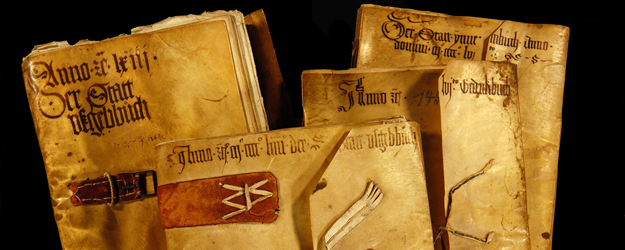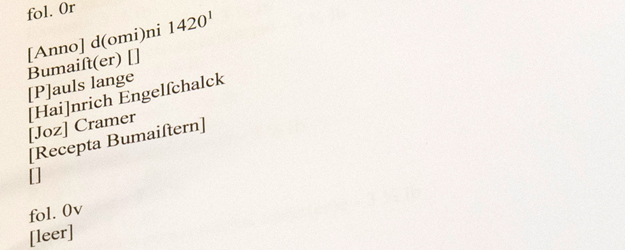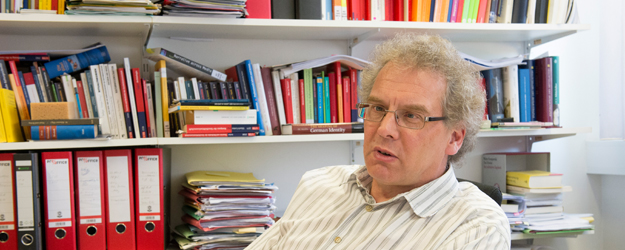29 May 2015
The Augsburg Master Builders' ledgers offer deep insights into the history of an important German imperial city. This nearly seamless chronicle extends over almost five hundred years. Professor Jörg Rogge of the Department of History of Johannes Gutenberg University Mainz (JGU) has initiated a project which aims at preparing a digital version of this amazing historical source documentation.
No, the originals are not in his office. "But wait, I must have something else here," says Professor Jörg Rogge of the Medieval History division of the Department of History at Johannes Gutenberg University Mainz. He looks through the files standing in rows on his shelves.
"This is a draft version for our application to the German Research Foundation." He opens a page. At the very top it says "Book 27". Below, the script of an individual page has been set out in meticulous detail while the various abbreviations used in the original have been deciphered. What appears for the lay person to be merely a baffling sequence of letters and figures suddenly reveals its meaning in this version: "Anno Domini 1420 ..."
Digital edition as a project funded by the German Research Foundation
The Augsburg Master Builders' ledgers are an extraordinary source of information. "We have old account books and invoice books for nearly every larger city and even for smaller communities in Germany," explains Rogge. "It is only the extent to which they have been preserved that differs." While some only start in about the year 1500, the Augsburg Master Builders' ledgers begin in 1320. And that is very early. In addition, they have survived in almost complete form to about the year 1800. There are large gaps in the records kept by many other cities." And Augsburg was a very important location, an imperial city, a mostly autonomous municipality that answered only to the emperor. "It was also extensively involved in international trade."
Rogge submitted an application to the German Research Foundation (DFG). Supported by a team of three members of staff, he planned to transcribe the Augsburg Master Builders' ledgers for the years 1320 to 1466 within 36 months. "There are 67 volumes with approximately 10,000 pages." The manuscript entries needed to be transcribed, annotations had to be added. Above all, the copious amounts of information were to be made accessible and usable online. The objective was to create an annotated digital edition. In 2014, the German Research Foundation approved a grant of EUR 400,000 towards the project being undertaken by the Research Unit Historical Cultural Sciences at JGU.
The historian flicks through the file again: "zol zu wertachprugg / drey sunntag 10 ½" – this is about the toll fees which were taken on the Wertach Bridge. Another entry says "Zimmerleut lon". "This shows us that the carpenters were paid every 14 days." Then there are details of the delivery of a consignment of "holtz" or timber. Rogge points at a further entry and smiles: "The city bought an amazing amount of nails."
Snowballs and lobbyists
There are even anecdotal entries. "The watchmen are instructed to arrest anyone throwing snowballs in the winter." That was in the 14th century. "From the third quarter of the 15th century, the city was paying lobbyists at the imperial court to represent the interests of Augsburg. They weren't called lobbyists then, of course, the word used was "Justitiar" in German or legal counselor. But they had the same task in principle."
The books document all sorts of things – from work on infrastructure, canal cleaning, personnel development measures through to the payment of alms to the poor. The material is a treasure trove of information for a wide variety of disciplines. It documents economic and financial history, cultural as well as social history.
The form of the books is also interesting. At the beginning they were written on parchment; paper began to be used only at a much later date. "Parchment is more durable than paper and the entries remain legible for much longer. They knew that even back then." The format and scope of the volumes grew as the city and the work of the municipal authority expanded. "The internal layout changed as well. In the 14th century they just wrote everything down in simple rows of script." Anything that did not fit in was added in the form of annotations in the margins. "Later the books had a predefined layout. The scribes prepared ruled columns for the entries because they knew that there would be recurring costs."
Transcription and technique
Even the language changed. "Until about 1360, all entries were made in Latin, then there was a trend toward writing in the vernacular." Another field of research opens up. When was it that the German word for "master builder" developed from "Bumaister" to "Baumeister"?
Rogge and his team cannot answer all of these questions – at least not within the framework of the DFG project. "We are just doing the groundwork." Their task is to open up the pages of the Augsburg Master Builder's ledgers to research.
"In our online edition, each page will be displayed in three different forms: a digitized image of the original page in high resolution, a transcription of the page, and the edited version." The latter offers an explanation of all abbreviations, coinage values are standardized, and annotations provide further help. Many of the terms will be provided with links to research databases.
"The transcription work is time-consuming, but we know what we are doing. The technical aspects are much more problematic," says Rogge. The hardware and various types of software needed to be appropriately coordinated. In addition, the software had to be modified to meet the requirements of research. "For that we need people who are not only familiar with our subject but have computer skills as well."
Virtual research environment
The Trier Center for Digital Humanities provided the necessary specialists. "We are working closely with Trier University and with the Mainz Academy of Sciences and Literature." Ultimately it is not just about providing the text of the Master Builders' ledgers for the purpose of reading. Researchers should be able to enter search terms and to explore a wide range of facets.
"The primary objective of the project was to make the Master Builders' ledgers accessible. Our secondary objective was to gain experience in the kind of problems that arise during the preparation of a digital edition and find out how to overcome these." Finally we wanted to see how the humanities can provide information resources in digital form in future.
"We still have many archives in traditional form which are not accessible online." For Rogge, the ideal situation would be a comprehensive virtual research environment put in place for humanities scholars. "That involves more than just posting a couple of images on the Internet. We have to really ask ourselves how historical materials can be processed to enable research to pose new questions. We also have to ask ourselves what kind of specialists we will need for this in the future. These are questions that are already being widely discussed."
The digital edition of the Augsburg Master Builders' ledgers is also a pilot project: Rogge and his team are determining what will be possible in the future.



